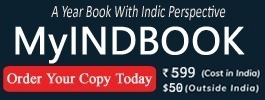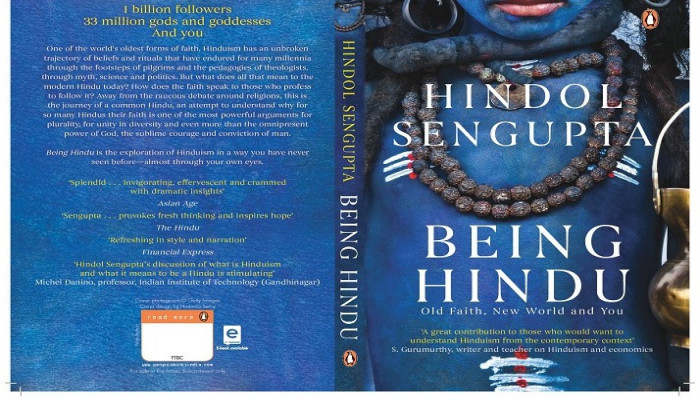Being Hindu: Old Faith, New World and You
- In Book Reviews
- 10:08 AM, Apr 18, 2023
- Richa Yadav
Eastern Answers for Theological Questions from the West
I had been rummaging through several books on comparative religion as I had plans to teach the subject for a college-level course. I got enough material on comparative religions but when it came to theology, I could not find much from a Hindu perspective on the subject ‘theology’. This is mainly because theologizing is mostly a West-driven academic discipline, deriving its postulates from the Bible. Theology means a systematic knowledge of God and an analytical study of dogmas related to the divine.
While the three major Abrahamic religions are theocentric, and they draw all the meaning and direction for their lives from their scriptures, the Hindu path is self-centric and encourages each practicing Hindu to find his own path and discover the divinity within oneself. The book by Hindol Sengupta brings out this difference in theological approaches and beautifully explains what we may call ‘Hindu theology’. This is the main contribution of the book.
Monotheistic religions have their Prophets who are said to have received the message of salvation from God Himself. Their revelations are collected from their scriptures. God is standing outside the realm of man, observing, judging, and dispensing justice for all human actions. Hinduism, on the other hand, does not have a Messiah or a holy book. There is no compulsion in anything, explains Hindol. What then makes a Hindu?
Hindol attempts to reiterate the basic tenets of dharma and articulates the philosophical core to fit well in the theological framework. He has emphasized in the entire book that for Hindus the starting point for any inquiry in the world is the self. You are not born with answers and are not asked to follow the scriptural words like other religions, but to question your own identity and find your own answers about ‘who am I?’ This is the essence of all Hindu beliefs, rituals and other practices like chanting and meditation.
The author says that often when Hindus are discussed, by themselves or by others, diversity is highlighted, but not many discuss the core of dharma; what binds the diversity of faith goes unexplained. Hindol says, “Practicing Christians and Muslims are more certain about what constitutes an identity of a being Christian or a Muslim and the idea of being a Hindu is far more amorphous and esoteric even. The spectrum is vast.” He explores those points which bind a variety of practicing Hindus together. He talks about the relationship between the self and the divine, the nature of truth, and ways of finding the self in Hindu scriptures
All religions are concerned with truth. Again, for Abrahamic religions truth lies in the scriptures. “In Hinduism, there is no truth to be found outside oneself. All this universe is Brahman, the self of all beings is Brahman says the Mandukya Upanishad. He who sees the self in all beings and all beings in the self henceforth has no more remorse says the Isha Upanishad,” the author says. The essence of Eastern worldview according to the author, “is the awareness of the unity and mutual interrelated of all things and events, the experience of all phenomena in the world as the manifestation of the basic oneness”. ‘Ekam sat vipra bahudha vadanti,’ that is ‘truth is one, but people say it in different ways’ is the core definition of truth for the Hindu faith.
Each soul is potentially divine is another key idea of Hindu dharma well-explained in the book. We are all God, and we have God within us. We just haven’t realized it. There is no world independent of human cognition. The so-called material world is a transformation, that is, a manifestation of Brahman.
Philosophical underpinning in all we do is fine but how to address the most pressing questions in day-to-day life? Can the big ideals address the deepest anxieties of a distressed Hindu mind? It is argued that it is simple to believe that we are divine, but it still does not solve our mundane worries and problems. Then we do need someone more powerful and kind than us to have mercy on us, love us, and be kind enough to help us in our time of crisis as all Abrahamic religions suggest.
Hindol again beautifully has articulated a response to this objection. He suggests that we need to utilize this knowledge that each soul is potentially divine. This idea has the potential to take away one’s “emotional and psychological crutches because when you realize that you have nothing to fall upon you know that you have to muster all the courage and face the situation bravely. The path to discovering divinity inside you is a path of extreme vulnerability. It is a path fraught with accepting your deepest insecurities and facing your most frightening demons. You cannot naturally hope to discover your inherent divine nature until you face your inner most anxieties,” Hindol writes.
The Sanatana dharma claims that man himself is God and places the responsibility of finding the truth on his shoulders. The Hindu journey of the quest is not to be of a follower but encourages you to find your own answers. This could bring solace to humans that they are not the only ones completely responsible for things, not the only ‘sinner’ in the world. This leads to another basic idea of dharma. The Hindu path has no sinners, taking a position diametrically opposite of what Abrahamic religions say, in Hindu dharma, there are no souls to sin and humans are born without any sin.
Hindol clearly articulates the idea of what being Hindu means. The text is simple and clear. Nothing new is given in the book but it helps the reader to get a perspective on Hindu faith, much needed in today's times. It is a must-read for people who want to conceptualize the basics of Hindu tenets more lucidly. However, the book may not be easy to understand for those who have no background in Hinduism.
His explanation of religion is based on the author’s own experience and helps clarify what the dharma is to non-Hindus with their biases and gore image of ‘caste, curry, and cow’ when it comes to understanding Hindu faith. Yet, people may find the book overly defensive because the author tries to give a secularist hue to his Hindu explanations at several places in the book. The notes and bibliography at the end of the book are valuable as they may propel the reader to dig deeper into the subject. In brief, I got most of my ‘theological answers’ for my course and the book helped me greatly in my academic pursuits.
Published by Penguin
Number of pages:171, published in 2015
Image source: IndiaFacts







Comments